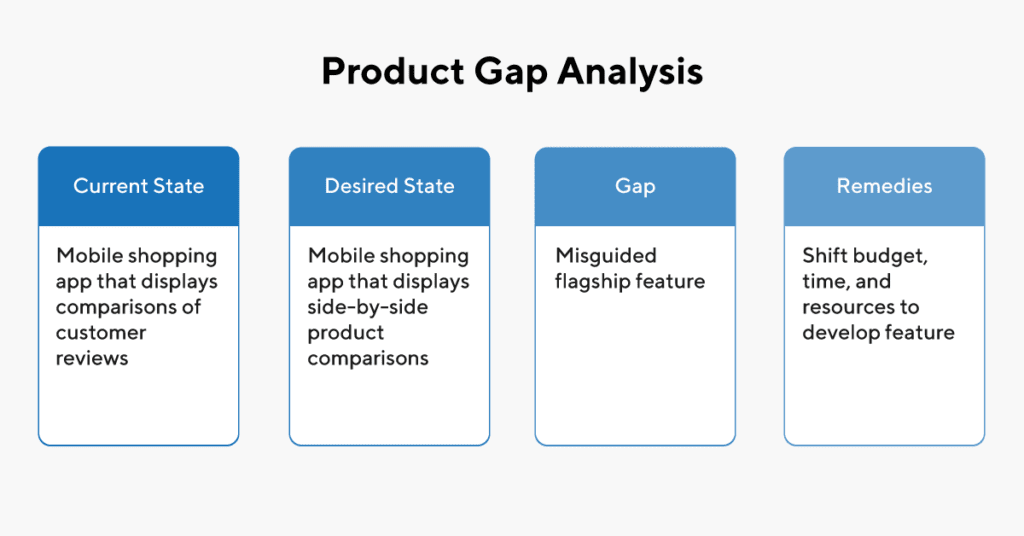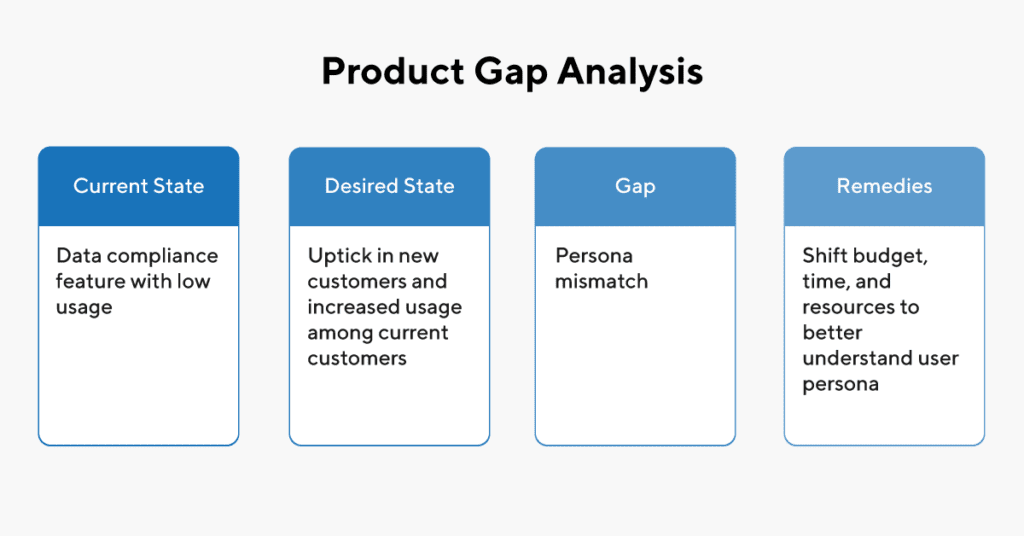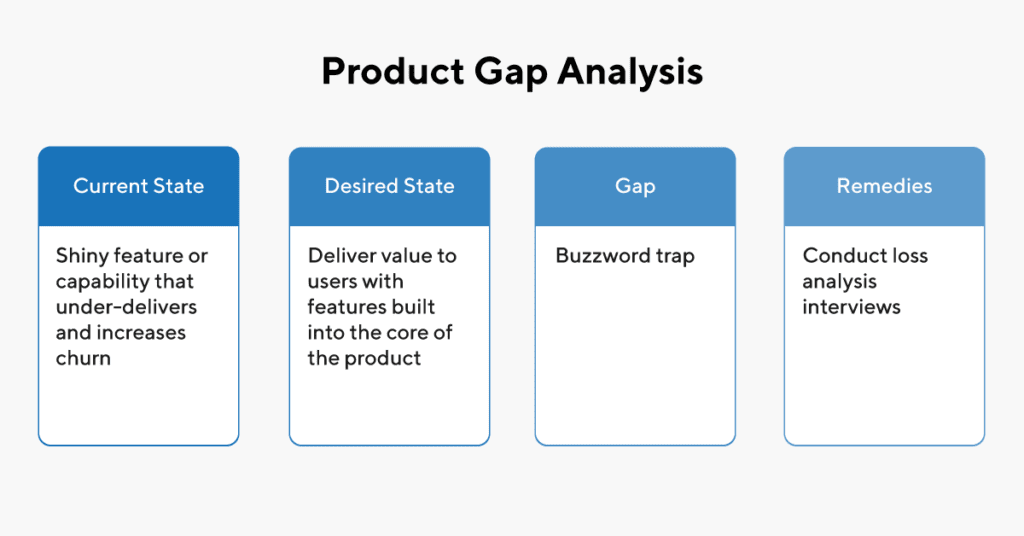Find the Product Gaps that are Killing Your Strategy
The product manager’s role often requires saying no to ideas for new products and requests to add features to existing ones. PMs have limited time, budget, and people to help them bring new products to the market. They need to be highly selective and choose only a few strategic initiatives at a time that they believe will move their product toward a company goal. And this can lead a PM to wonder: Are we saying no too much? Are we ignoring product gaps? Are those gaps undermining our product’s strategy?
No product will ever be perfect. There will always be some percentage of customers who find it lacking. Many people complain about the iPhone—one of the most successful consumer electronic products in history. The only way to discover what a product is missing, or why it might fail to resonate with users, is to release the product to the market.
But even after you’ve launched your product, you still need a process for identifying potential product gaps. Let’s discuss a few ideas for doing this.
There’s More Than One Type of Product Gap
When we hear the term product gap, most product professionals immediately think of features or functionality that are missing from a product. That’s one way to leave a gap in your product strategy. But there are others. Here are a few examples.
1. Misguided flagship feature
A company can create a product gap by putting a lot of resources and attention into a feature that users don’t find useful. This type of product gap arises not from failing to include an important feature but instead building the product around a flagship piece of functionality the market doesn’t want.

What this might look like:
Imagine your company built a mobile shopping app that lets users view products from various vendors side by side before buying. Your research told you consumers are eager for comparison-shopping mobile apps.
But as you developed the strategy, your team got enthusiastic about an idea to display comparisons of customer reviews for vendors. This functionality became the focus of your development time, budget, and marketing campaign. You went to market touting a mobile app to compare vendor reputations—when your persona was looking for side-by-side product comparisons.
2. Persona mismatch
Another way you can leave a product gap is by positioning your product for the wrong persona.

What this might look like:
Let’s say your team decides to add data compliance to the product you offer. To test this idea’s validity, you produce content—webinars, blog posts, white papers—about how businesses should handle data compliance. That content campaign generates tremendous attention, so you build the feature into your product.
Then you release it to the market. And despite a big PR and marketing campaign, you don’t see an uptick in new customers. Your existing users aren’t using the feature either.
Your mistake here was failing to learn about the people engaging with your content on data compliance. Those were IT and corporate security professionals. But your product’s user personas are database administrators and data analysts. You created a gap in your product strategy by developing a viable feature for one persona. However, you’re marketing the product to a different persona entirely.
3. The buzzword trap
A company can also create a product gap by chasing an industry trend or trying to keep up with a hot topic. Here’s how this can play out.

What this might look like:
Imagine your product team receives an increasing number of questions about or requests for a specific type of capability that’s getting a lot of attention in your industry: responsive design, DevOps, HIPAA compliance, etc.
So, your team scrambles to build something—anything—into your product that lets you answer yes to the question: Do you have that?
The problem is that this feature or capability is merely an afterthought, not built into the core of your product. New users will recognize this. If they need a true DevOps tool or HIPAA compliance for every aspect of the app, they’ll see that your app under-delivers, and they’ll find another option.
How do You Spot and Fix Product Gaps?
Now that you understand a product gap can reveal itself in many ways—not only as an item missing from your product—the next question is: How do you find them so you can fix them? You can use several methods.
1. Loss Analysis
If you find your company failing to convert leads and prospects into customers, one way to figure out what the problem is—where the product gap lies—is to ask those leads why they chose not to buy your product. You might have lost a potential customer, but you can still gain invaluable business intelligence.
What to do:
Your team should have a process in place to communicate with your website visitors, blog readers, webinar attendees, or trial users of your product. After a certain period, or a certain number of marketing communications, if these people have not purchased from you, send them a short survey asking them why.
Useful questions here include:
· Was there a single reason you chose not to purchase our product?
· Is there a feature or capability that would have changed your mind?
2. Competitive Analysis
If your product isn’t generating the numbers of sales or overall revenue you anticipated, another reason might be that your target customers are finding your competitors’ products more valuable.
What to do:
Conduct regular competitive research. Review your product objectively (well, as objectively as you can) against the offerings of competitors who are growing faster than your company or enjoying more market share.
As you conduct this review, ask tough questions: Are these competitors offering solutions we don’t? Are they highlighting functionality our company isn’t? Those competitors are doing market research just like you are. Maybe they’ve learned things about your personas that you’ve missed.
3. Product Analysis
You can also find clues to a product gap right in your product’s usage metrics. If users aren’t engaging with your product as often as you anticipated, or in the ways you expected, these could be indicators that you’re missing something.
What to do:
Implement product analytics and review those data frequently. First, estimate the numbers that will indicate success across various key metrics. These could include average per-session time spent in your product, the number of times users access a given feature, the percentage of users who search for your help file, etc.
Then monitor the actual numbers over time and review them against your expectations. Where you find discrepancies—for example, far more people searching for help than you anticipated—you might have found a product gap.
Note: Thanks to the prevalence and affordability of data-analytics tools, you can use the product-analysis approach to zero in on highly specific product gaps. For example, if you have a mobile app and you discover many people visiting your website asking for an Android version, or searching for integrations, these questions could provide the solution to your product gaps.
Download The Product Strategy Playbook ➜
Don’t Let Potential Product Gaps Slow Your Strategy.
If there’s one thing you take away from this post, let it be this: No product manager will ever have perfect and complete information before launching a product. Your product strategy will develop gaps. It’s inevitable. But that’s not the primary danger.
The primary danger is getting stuck in an endless loop looking for features or functionality you might have overlooked. If you fall into this decision-paralysis trap, you’ll never release a product.
The best strategy is to find the right balance. Use the strategies above to stay on the lookout for the product gaps you might be allowing to open in your product strategy. At the same time, though, keep your product moving forward and continue learning from your market. Use those learnings to keep making your product better.



